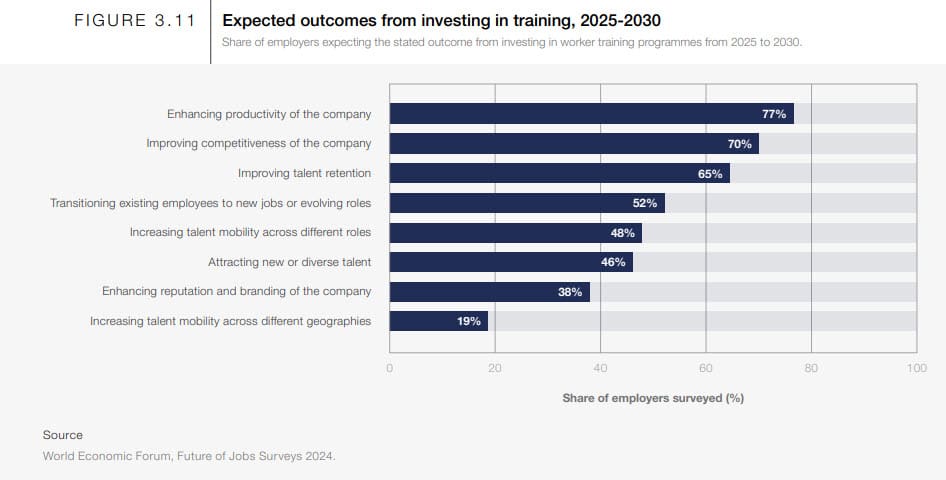
Skills Shortages 2023-2025 - the Research
Key Points
- What is meant by skills shortage
- Largest skills shortages
- 4 Types of Skills Shortages
- Causes of Skills Shortages
- Impact of Skills Shortages
- Global Position 2025
- Skills Shortage Projections by Region
- Projected Core and Technical skill Requirements to 2030
- What Skills can Generative most easily AI replace
- Strategies to combat skills shortages
What is a skills shortage?
refers to a lack of individuals with the necessary skills, qualifications, or expertise to meet the demands of specific job roles or industries. It occurs when employers have difficulty finding candidates with the right skill set to fill their job openings, resulting in vacant positions or delays in recruiting suitable talent.
The Randstat 2024 Global In demand skills dashboard provides an overview of demand and vacancy rates in particular skills across the most in demand skills groups –
- AI & Automation
- Cloud Services
- Data Science/Analytics
- Software Project Management
- Audit & Compliance
- Customer Services
- Engineering & Maintenance
- Finance & Accounting
- Marketing, Content & Advertising
4 types of skills shortages
High Demand

There is a high demand for certain skills, but not enough qualified individuals to meet that demand. This situation is found in rapidly evolving industries or in fields where technology advancements have outpaced the availability of skilled workers.
Over qualified candidates

Their qualifications, education, or experience exceeds the requirements of the job they are applying for. This means they are looking for higher remuneration and are a likely retention risk. Overqualified candidates are more common during economic downturns or in regions with limited job opportunities. In these situations individuals will accept jobs beneath their skill level to secure employment.
Under qualified candidates

They don’t have the necessary skills, education, or experience to meet the requirements of the job they are seeking. This situation results from a lack of accessible training and educational opportunities. It may be found just in particular regions or more generally when there is a mismatch between the skills taught and industry needs.
Candidates have the wrong skills

Their skills set is not relevant or is not in demand by employers. This situation is a result of industry decline – such as the coal industry – so that these skills become obsolete or less valuable.
Main Causes of Skills Shortages
Technology advances & evolving job roles

New technologies drive requirements for entirely new skills, as well as the application of the skills for the 4th Industrial Revolution (4IR) with a new focus on environmental sustainability.
Outdated Education & Training

There is little doubt that academia has not kept pace with the requirements for work ready graduates. Functional literacy in developed nations is on the decline, partly due to Covid, but also to societal change from social media. This has led to under utilisation of those in younger age groups due to limited employability.
Global competition

In many fields, and especially Healthcare, Secondary Education and Technology, organizations are recruiting globally and trying to entice workers from other nations with more attractive living conditions, pay and benefits. Countries with fewer such advantages suffer a ‘brain drain”
Local economy & industries
Urban areas tend to have more industry, and some such as Silicon Valley a concentration of a particular industry type. This creates a higher demand for particular skills, but also a larger labour pool. Rural areas with a greater variety of industry have a smaller labour pool and greater skills shortages.
Population trends
In many parts of the world the population is aging and the birth rate falling. In numerical terms this may, to some extent, offset the reduction in jobs due to automation.
Government policies
In a global labour market immigration policies impact the free flow of skills, and thus skills shortages. Government subsidized action to address retraining for workers in obsolete roles or industries is needed to rebalance skill sets. Incentives may need to be in place to attract workers to rural areas.
Impact of Skills Shortages for Organizations
- Higher labour costs as organizations compete for staff
- Delayed projects and reduced output due to unfilled vacancies
- Reduced ability to innovate and compete in the market place
- Some organizations may resort to outsourcing and offshoring which may have adverse impact on reliability and quality.

Global skills position - World Economic Forum survey 2023 - 2025 key findings
The 2023 World Economic Forum report on the Future of Work includes comment on global skills shortages by job role.
 In developed countries key shortages are for Nurses, Software Developers, Systems Analysts, Plumbers & Pipefitters, Welders, Bricklayers and Heavy Goods Vehicle Drivers, as well as Agricultural and Forestry workers.
In developed countries key shortages are for Nurses, Software Developers, Systems Analysts, Plumbers & Pipefitters, Welders, Bricklayers and Heavy Goods Vehicle Drivers, as well as Agricultural and Forestry workers.
In 2023 the most rapidly growing jobs are in the Sales field and Customer Success.
In 2025 the most rapidly growing list is in technology; Data Analysts and Scientists, Big Data Specialists, Business Intelligence Analysts, Database and Network Professionals, and Data Engineers, Information Security Analysts expected to have up to 35% growth. Roles related to AI technology are expected to grow by 40%.
While Business Development roles are still important the digitization of marketing activity means in person sales roles are declining.
In many countries Healthcare and Social Services jobs have grown significantly, a result of the COVID pandemic and aging populations.
Clerical and secretarial roles are the fastest declining, for example Bank Tellers, Postal Service Clerks, Cashiers and Ticket Clerks. Accounting, Bookkeeping and payroll roles are also declining fast.
Face-to-face and record-keeping roles are declining in all industries but reducing especially fast in Information Technology.
Overall on 2023 more than 20% of roles were expected to be affected by change (creation of new roles, redundant roles) with survey respondents indicating that in 2023 some 63 million new jobs will be created – and 83 million jobs will become obsolete. A net loss of 14 million jobs.
The 2025 World Economic Forum future of jobs report While 22% of roles are expected to be affected, 170 million new jobs and 98 million dis- established jobs are expected – a net gain of 78 million jobs. Reflecting the gradual recovery after COVID and a 7-8% job growth to the end of the decade with more new jobs created than those destroyed by technology advances.
The fastest growing jobs continue to be in IS and data technology. The shrinking job roles largely in clerical and administrative roles, as well as in those industries where products have been highly digitized – such as printing.
Peter Bendor-Samuel has pointed out that many organizations see the skills shortage as a near term problem that will disappear as economies slow and even go into inflation. Employees will be less prone to change job, retire or shorten working hours when the employment situation is more precarious.
However the digitalization of almost everything is creating an exponential need for highly skilled engineering and IT staff. While historically this need has been filled by Indian and East European talent these sources are now dwindling.
On top of that are the shrinking workforces in the developed countries as well as China. In India the workforce decline is projected to begin in another decade.
Skills Shortage Projections for USA
An American Action Forum report has suggested the skill shortage for jobs requiring a college degree may reach close to 9 million over the next decade with a further three quarters of a million short for jobs requiring at least some college education. This is approaching 6% of a workforce declining due to aging, lower work participation rates and slower population growth.
The World Bank predicts that in the US the next decade will see the number of people of working age (between ages 15 and 65) decline by over 3 percent.
A survey by the publisher Wiley found that 69% of US firms are experiencing difficulty finding staff with the right skills versus 55% in 2021.
A recent Deloitte report on talent in the technology industry finds 90% of these firms said recruiting is still a major challenge despite layoffs numbering over 150,000 so far in 2023. The most difficult roles to fill are for those in AI, automation and Machine Learning as well as those able to understand systems as a whole – system architects and those with skills in cloud security and infrastructure.
In 2025 overall it is roles in healthcare, social services and software development that continue to have the most demand.
The US chamber of Commerce outlines some of the factors behind current workforce shortages.
The lingering effects the Covid pandemic may be responsible for the drop in workforce participation as some of those laid off, particularly women, are reluctant to go back to work due to family needs at home, ill health or preferring to retrain first. Problems in accessing reliable childcare are a contributing factor. The pandemic payouts meant that for some workers they received more in benefits than for being in work.
On top of this early retirements increased and legal immigration reduced.
Skills shortages in Australia and New Zealand
In 2023 an Australian CEO Survey from the Australian Industry Group found that skills shortages are worsening.
• 90% of businesses expect to be affected by staffing shortages in 2023
• 36% report that skills shortages will inhibit their business growth
• 26% say that total labour shortages – both skilled and non-skilled – would inhibit growth
While it is commonly thought that skills shortages are mainly in technical roles, in fact 74% of businesses reported they are affected by low literacy and numeracy skills. They reported managers and professionals as having the greatest development needs in generic skills.
In 2025 the Industries most affected by skills shortages continue to be Mining and Construction, affected by shortages of skilled trades, technicians and operators, Healthcare across most roles and in ICT those roles focused on data and cybersecurity.
In New Zealand, the 2023 Employers and Manufacturers Association Survey found 90% of employers struggling to fill vacancies with over 70% saying the situation was worst for high skill roles. More than half of CEOs said that labour shortages are likely to impact their profitability in the next decade.
In 2025, as in Australia it is easier to fill vacancies. As in most developed economies key shortages are in digital technology especially analytics and cyber security, as well as healthcare and trades roles.
Skills shortages in Asia
The report Deciphering Labor and Skill Shortages in Asia with Workforce Analytics, was

compiled by the Workforce Analytics Institute (WAI), a partnership between The Conference Board and Mercer. It suggests that the emerging economies in Asia (Malaysia, Thailand, the Philippines, Indonesia, China, India, Vietnam, Nepal, Bangladesh, Cambodia, Pakistan, and Myanmar) will experience severe skilled labour shortages in the near and medium term. This is because, in most cases, despite large working age populations, their education systems do not provide effective skills-based training.
In contrast the more developed countries – Singapore, Japan and Korea have a very high proportion of the population with advanced skills
In China the effect of the one child policy has contributed to a decline in working age population and the supply of tertiary or vocationally educated workers will be significantly below projected demand in the next 10 years.
India’s has a relatively young population but a very small percentage (around 2%) are skilled. Many of the skilled workers migrate to the developed countries . This dynamic will create severe shortages for India in the coming decade.
Similarly Indonesia has a young population with more than 63 percent of its population below age 35. Much like India only a small percentage of the population has tertiary education – approximately 4%. The demand for skilled labour is forecasted to grow from 55 million in 2012 to 113 million in 2030 creating intense pressure.
The education system in the Philippines is relatively more effective in producing a more skilled workforce, but many migrate to fill demand in developing countries leaving the Philippines with a shortage in highly skilled labour.
In 2025 shortages are less acute in the mature markets of Singapore and HongKong due to economic uncertainty. In the faster growing economies while technical skills are strong, there is a need to pair these with improved social skills.
Core skills in 2025 and beyond
The Nash Digital Leadership report has outlined how the automation of simple tasks means that employees are increasingly involved in more complex aspects of work.
Consistent with this, The World Economic Forum Future of Work report 2025 found cognitive skills – especially analytical skills, are still the most important. Resilience and flexibility, influence and leadership skills are rated second and third, higher than in 2023.
- Analytical thinking
- Resilience, flexibility and agility
- Leadership and social influence
Creative thinking and technological literacy now come in 4th and 6th rather than second and third. Talent Management comes into the list at number 10. Along with these skills, motivation remains in the top 10, lifelong learning rises to 8 and empathy and listening to number 7. Dependability and attention to detail has dropped to position 14.
This trend reflects the increasing use of technology to do routine jobs that require attention to detail, and the complexity of the increasing number of roles that work on or with technology.
Employability
Employability is a skills related concept that indicates what are regarded as essential career skills and qualities.
Often split  into 3 categories
into 3 categories
- Know-Why – personal goals, interests and motivation and fit with the organisation’s values, purpose and culture.
- Know- How – job relevant knowledge and skills plus personal adaptability (learning agility, accountability, self-efficacy)
- Know-Whom – social capital – social and professional networks and interpersonal relationships
Digital Skills
In terms of Know-How, since organizations are adopting technology at an increasing rate, there is a chronic shortage of ” Digital skills”.
In the 82 countries surveyed by Nash Squared for its Digital Leadership Report 2022, 58 per cent of tech company leaders expected their “skills needs” to increase. 70% of the respondents said their organization was adversely impacted by skills shortages, many unable to keep up with change.
Respondents reported data analysts, cybersecurity specialists and technical architects as the top 3 skill sets needed. 60% of respondents said that the skills shortage is making the cost of talent unsustainable, even though it can be sourced globally from emerging economies.
In the World Economic Forum data, for the US, China, Indonesia and Brazil the technical skills most frequently mentioned are AI and Big Data. Organisations report that these topics will make up approximately 40% of their training budget. However this is not aligned with the level of investment they expect to make in these technologies in the next 5 years, which sees a more cautious approach.
4IR Skills
4IR – the Fourth Industrial Revolution is the the convergence of digital, physical, and biological technologies. It is having significant consequences for all jobs and activities. The skills that the entire population will need include:
Digital Literacy – the ability to effectively use digital technology. This includes the use of digital devices including smartphones, mobile and desktop computing devices. Individuals must understand practises to ensure digital security and privacy, make use of the internet for information and on-line transactions, as well as using applications to enhance personal productivity and convenience.
Digital ethics – understanding the responsible use of technology including maintaining privacy, informed consent and the avoidance of harm. This is essential for individuals and organizations alike.
Data Literacy – with the huge increase in data availability, the ability to understand, analyze, and interpret that data is critical. Individuals need to be able to assess data validity and identify misinformation. They need to be able to make “data-driven decisions”. To that end, basic skills in creating and interpreting visual representations of data and understanding the role of statistics in establishing validity, are becoming essential for all in the workforce.
Artificial Intelligence – Machine Learning – with the enormous hype around AI we all need to understand the basics of what it is, what it can and can’t do, the mistakes it makes, and how some of its applications – especially in the employment arena – have doubtful validity

Critical Thinking and Creative Problem-Solving – as routine tasks are automated, the ability to solve complex problems by analysing root causes, thinking creatively (outside the usual boundaries) to come up with innovative solutions is increasingly important for many jobs.
Adaptability and Flexibility – the technological revolution is bringing rapid change. The workforce must be able to adapt. Of critical importance is the ability and openness to learning new skills, to taking on new roles.
Interpersonal Skills – often described as emotional intelligence. The ability to communicate effectively by understanding and listening to others, collaborating, sharing information and creating simple and clear messages on complex issues.
Technical Skills
The WEF 2025 Future of Jobs report lists those skills expected to be in greatest demand
In technology
- AI and Big Data
- Networks and Cybersecurity
- Technological Literacy in general
The technical workforce also needs to develop their skills in;
Coding and Programming: Basic coding and programming skills are becoming increasingly valuable, even in non-technical roles. Knowing how to work with programming languages can help individuals automate tasks and leverage technology effectively. In software development AI is replacing or augmenting many tasks.
What skills will Generative AI replace?
Generative AI expects (in ChatGPT’s own opinion) to be able to replace a percentage of tasks listed by WEF in its Global Skills Taxonomy. It considers the skills most easily replaced are;
- Artificial intelligence and big data
- Marketing and media
- Systems thinking
- Multi-lingualism – Translation – Interpreting
- Programming – software development
- Financial management
It also believes it can do most tasks involved in Reading, writing and mathematics – though these tasks are of course fundamental to the cognitive skills and problem solving that requires human input.
How to combat the skills shortage and stay competitive
The WEF 2023 survey found that the most common business strategies for success are investment in on job training and automation – mentioned by over 80% of respondents. However only 34% expected to actually invest in reskilling and upskilling their workforce to improve talent availability.
Nevertheless, over 80% planned to invest in education and workforce development technologies in the next five years.
Almost 50% expected to train workers to transition from roles becoming obsolete to new roles. Most training will be provided internally and much of it on the job.
48% of respondents report initiatives to improve career progression and advancement processes and information to improve availability of skilled staff through individual development and internal hiring.
The WEF 2025 report indicates an increase to 85% of reespondents planning to invest in workforce development up to 2030. There is also now a strong intention to invest in technology to automate some proceeses and tasks (72%) or to use technology to augment human effort. (63%)
Despite ongoing skills shortages 70% of respondents expect to hire in people with the new skills they need, close to 50% will engage in some upskilling, and over 40% expect to retrench staff with obsolete skills.
In the following 2024 WEF survey overall responses of a small sample indicate 41% of staff will not need training, 29% will need upskilling in their current role and 19% upskilling for a new role – similar in total percentage of upskilling. In this survey respondents said 11 % would not receive neccessary upskilling indicating constraints on access to upskilling resources and/or suitable candidates for re-skilling.
The expected benefits of training investment in the WEF 2024 survey are mainly enhancement of organizational productivity and competitiveness followed by staff retention.

Strategy for AI
In the WEF 2025 report which specifically asks about the impact of AI on workforce planning – 77% plan to upskill their existing workforce to work with AI. Consistent with overall strategy, 69% will look for new people with skills to work with AI and 41% will be looking to reduce staff that can be replaced by AI.
Move on from traditional hiring practices
In the face of significant skills shortages the WEF 2025 survey shows organizations are changing their hiring practices, reducing the emphasis on academic qualifications now required by 43% of respondents.
However the percentage using evaluation of prior work experience as their skills-assessment methodology has increased from 75% to 81%. This despite the prevalence of CV fraud.
The use of pre-employment tests is in second place at 48%, despite issues around validity and reliability.
The continuing emphasis on this type of information for hiring decisions excludes talent without academic qualifications, impressive resumes, and test-taking nous, who may nevertheless have suitable skills and growth potential.

Despite the stated emphasis on skills in workforce strategies many organisations have not adopted skills-based hiring practices.
What is skills based hiring?
In short hiring on the basis of demonstrated skills and competencies.
The difficulty is how to assess that. Many organizations struggle in this area.
In the WEF survey 47% of organisations say they use proprietary skills assessments. However most proprietary skills assessments are for particular Information Technology skills, such as coding in Java.
27% say they use psychometric testing but this has very limited validity for job performance. Cognitive skills (General Mental Ability) and the personality factor of conscientiousness are the only significant indicators. Recent research puts them at a similar level or less reliable than a coin toss. (footnote)
20% of respondent organization report using completion of short courses as a key indicator of skills. The problem is that training is not always an accurate indicator of on job skills. Training is not automatically applied on the job and or it may not be sufficiently relevant.
Learn how to introduce effective skills based hiring.
Use an Integrated Workforce Capability Management System
In most organizations information on job requirements, capability/competency requirements, performance and learning resources is either mostly missing, poor-quality, fragmented or not aligned. In most cases little of this information is aligned to the organizational strategy.
This makes it almost impossible to get an accurate idea of what skills are needed now and in the future and where the current skills gaps are.
Lacking this information training initiatives cannot be focused on the imperatives and may be both costly and ineffective.
Centranum Talent Management Platform
The Centranum platform provides tools for integrated WorkForce Capability Management including identification of
- Job specific knowledge and skill requirements,
- Identification and showcasing of career pathways
- Competency/skill evaluation and gap analysis
- Relevant Learning Resources & Training Management
- Individual Development pathways and programmes
- Capability Tracking across the organisation
- Tools for Skills Based Hiring decisions
- Career & Succession Planning
